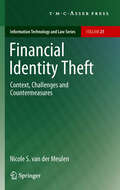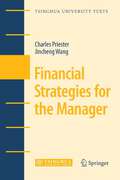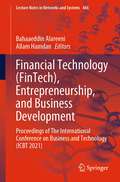- Table View
- List View
Final Target: The Old Ways Die Hard (Josh Thane Thriller #2)
by E. V. SeymourThe old ways die hard… A gripping thriller full of shocking twists from E. V. Seymour, perfect for fans of Mark Dawson, Lee Child and David Baldacci.
Finance and Control for Construction
by Chris MarchDrawing on a wealth of practical experience, both in the construction industry and teaching students, Chris March presents this study of construction management and the major aspects of controlling the building process. Covering the stages from the client's initiation, to the final handover of the building, March includes evidence from those currently working in the industry, and covers the key industry requirements: knowing that in today's market place, those entering the field must be aware of how projects are financed and controlled, and to financially run and maintain a building. Finance and Control for Construction examines the various stages, from development, through the design, to procurement and post-contract processes, and culminates in a discourse on facilities management. This book is written with a down-to-earth approach, with evidence supporting theories and principles, and is a book that students of construction management and related subjects need if they wish to succeed in the field.
Finance and Control for Construction
by Chris MarchDrawing on a wealth of practical experience, both in the construction industry and teaching students, Chris March presents this study of construction management and the major aspects of controlling the building process. Covering the stages from the client's initiation, to the final handover of the building, March includes evidence from those currently working in the industry, and covers the key industry requirements: knowing that in today's market place, those entering the field must be aware of how projects are financed and controlled, and to financially run and maintain a building. Finance and Control for Construction examines the various stages, from development, through the design, to procurement and post-contract processes, and culminates in a discourse on facilities management. This book is written with a down-to-earth approach, with evidence supporting theories and principles, and is a book that students of construction management and related subjects need if they wish to succeed in the field.
Finance and Technological Change: Theory and Evidence
by E. Santarelli`A pioneering and valuable study linking finance to innovative activity: not only is the theoretical framework sound, thought-provoking and creative, but amply supported through systematic empirical testing.' - David B. Audretsch, Wissenschaftszentrum Berlin fur Sozialforschung This book broadens the economic explanation of technological change, by assuming that development and diffusion of new technologies are closely related to the financial arrangements and institutions which prevail in any given historical period. To support his hypothesis, the author combines theoretical prescriptions with empirical evidence: the interdependences between technology and finance suggested in the first part of the book are therefore analysed from a historical perspective, and a theoretical model is then applied to explain how R&D is funded by new and already established firms in the data processing industry. The book concludes with a survey of policy interventions towards various sources of innovation financing.
Finance for Engineers: Evaluation and Funding of Capital Projects
by Frank CrundwellWith flair and an originality of approach, Crundwell brings his considerable experience to bear on this crucial topic. Uniquely, this book discusses the technical and financial aspects of decision-making in engineering and demonstrates these through case studies. It’s a hugely important matter as, of course, engineering solutions and financial decisions are intimately tied together. The best engineers combine the technical and financial cases in determining new solutions to opportunities, challenges and problems. To get your project approved, no matter the size of it, the financial case must be clear and compelling. This book provides a framework for engineers and scientists to undertake financial evaluations and assessments of engineering or production projects.
Finance Policy for Renewable Energy and a Sustainable Environment
by Michael CurleyEnvironmental finance is about creating the greatest environmental benefit for the largest number of people at the lowest possible cost. That is the first and most important principle listed in Finance Policy for Renewable Energy and a Sustainable Environment. Focusing on what the author considers to be the 23 principles of environmental finance, t
Finance Transformation: Leadership on Digital Transformation and Disruptive Innovation
by Aikta Varma Tarnveer SinghFinance Transformation: Leadership on Digital Transformation and Disruptive Innovation is a general and wide-ranging survey of finance transformation and emerging technologies. Finance and IT have long been important areas of any business, but recent technological developments are innovating and disrupting both. This book lays a path towards the benefits and away from potential risks. It covers the widest array of topics, from quantum computing to blockchain technology, from organisational culture and diversity to hybrid working, and from regulation to cybersecurity. Written by two vastly experienced industry professionals, this book includes real-life examples and up-to-date references. It will be of particular interest to business stakeholders, executives, and policymakers.
Finance Transformation: Leadership on Digital Transformation and Disruptive Innovation
by Aikta Varma Tarnveer SinghFinance Transformation: Leadership on Digital Transformation and Disruptive Innovation is a general and wide-ranging survey of finance transformation and emerging technologies. Finance and IT have long been important areas of any business, but recent technological developments are innovating and disrupting both. This book lays a path towards the benefits and away from potential risks. It covers the widest array of topics, from quantum computing to blockchain technology, from organisational culture and diversity to hybrid working, and from regulation to cybersecurity. Written by two vastly experienced industry professionals, this book includes real-life examples and up-to-date references. It will be of particular interest to business stakeholders, executives, and policymakers.
Financial Cryptography and Data Security: 21st International Conference, FC 2017, Sliema, Malta, April 3-7, 2017, Revised Selected Papers (Lecture Notes in Computer Science #10322)
by Aggelos KiayiasThis book constitutes the thoroughly refereed post-conference proceedings of the 21st International Conference on Financial Cryptography and Data Security, FC 2017, held in Sliema, Malta, in April 2017. The 30 revised full papers and 5 short papers were carefully selected and reviewed from 132 submissions. The papers are grouped in the following topical sections: Privacy and Identity Management; Privacy and Data Processing; Cryptographic Primitives and API's; Vulnerabilities and Exploits; Blockchain Technology; Security of Internet Protocols; Blind signatures; Searching and Processing Private Data; Secure Channel Protocols; and Privacy in Data Storage and Retrieval.
Financial Econometrics: Bayesian Analysis, Quantum Uncertainty, and Related Topics (Studies in Systems, Decision and Control #427)
by Nguyen Ngoc Thach Vladik Kreinovich Doan Thanh Ha Nguyen Duc TrungThis book overviews latest ideas and developments in financial econometrics, with an emphasis on how to best use prior knowledge (e.g., Bayesian way) and how to best use successful data processing techniques from other application areas (e.g., from quantum physics). The book also covers applications to economy-related phenomena ranging from traditionally analyzed phenomena such as manufacturing, food industry, and taxes, to newer-to-analyze phenomena such as cryptocurrencies, influencer marketing, COVID-19 pandemic, financial fraud detection, corruption, and shadow economy. This book will inspire practitioners to learn how to apply state-of-the-art Bayesian, quantum, and related techniques to economic and financial problems and inspire researchers to further improve the existing techniques and come up with new techniques for studying economic and financial phenomena. The book will also be of interest to students interested in latest ideas and results.
Financial Feasibility Studies for Property Development: Theory and Practice
by Tim HavardEssential for any real estate professional or student performing feasibility studies for property development using Microsoft Excel and two of the most commonly used proprietary software systems, Argus Developer and Estate Master DF. This is the first book to not only review the place of financial feasibility studies in the property development process, but to examine both the theory and mechanics of feasibility studies through the construction of user friendly examples using these software systems. The development process has seen considerable changes in practice in recent years as developers and advisors have adopted modern spread sheets and software models to carry out feasibility studies and appraisals. This has greatly extended their ability to model more complex developments and more sophisticated funding arrangements, saving time and improving accuracy. Tim Havard brings over 25 years of industry and software experience to guide students and practitioners through the theory of development appraisals and feasibility studies before providing internationally applicable worked examples and potential pitfalls using Excel, Argus Developer and Estates Master DF.
Financial Feasibility Studies for Property Development: Theory and Practice
by Tim HavardEssential for any real estate professional or student performing feasibility studies for property development using Microsoft Excel and two of the most commonly used proprietary software systems, Argus Developer and Estate Master DF. This is the first book to not only review the place of financial feasibility studies in the property development process, but to examine both the theory and mechanics of feasibility studies through the construction of user friendly examples using these software systems. The development process has seen considerable changes in practice in recent years as developers and advisors have adopted modern spread sheets and software models to carry out feasibility studies and appraisals. This has greatly extended their ability to model more complex developments and more sophisticated funding arrangements, saving time and improving accuracy. Tim Havard brings over 25 years of industry and software experience to guide students and practitioners through the theory of development appraisals and feasibility studies before providing internationally applicable worked examples and potential pitfalls using Excel, Argus Developer and Estates Master DF.
Financial Identity Theft: Context, Challenges and Countermeasures (Information Technology and Law Series #21)
by Nicole S. van der MeulenThe existence of financial identity theft in the United States, and its (gradual) spread to other areas of the world, increases the need to understand how identity theft occurs and how perpetrators of the crime manage to take advantage of developments within contemporary society. This book aims to provide such an understanding through an in-depth comparative analysis which illustrates how states, financial service providers, consumers, and others facilitate the occurrence of financial identity theft in the United States and the Netherlands.
Financial Justification of Nondestructive Testing: Cost of Quality in Manufacturing
by Emmanuel P. PapadakisFinance is not, in general, a part of the curriculum for scientists, engineers, and even nondestructive testing (NDT) specialists. Therefore, justifying proposals for new methods and equipment that may seemingly add a modicum of cost to the production process can be problematic. Financial Justification of Nondestructive Testing not only explains ho
Financial Management and Accounting Fundamentals for Construction
by Daniel W. Halpin Bolivar A. SeniorTECHNOLOGY/ENGINEERING/CIVIL SUCCESSFUL FINANCIAL MANAGEMENT IN THE CONSTRUCTION INDUSTRY BEGINS WITH THIS HANDS-ON GUIDE While construction professionals are skilled in the technical side of their work, they often find the financial management aspect of the business daunting. Financial Management and Accounting Fundamentals for Construction will help you better understand and navigate the financial decisions that are part of every construction project. This book is a compact summary of the basic financial skills that a construction professional must have to be successful in the management of a construction company and its projects. Its topics address many of the questions that any construction administrator will face, such as: How to organize and use a company's financial reports What amount of cash must be made available to the contractor to complete a project Why the early payment of supplier invoices can enhance profitability How to quantify the time value of money in financial decisions What tax amount is owed by a company and how it impacts the bottom line How to control project costs What financial sources are available to a construction contractor for capital expansion In this text, you will learn about accounting fundamentals, project-related financial matters, and company level financial issues—three factors that are key to your career success. An ideal reference for students of construction management and engineering, as well as professionals who need a quick refresher when dealing with cost control analysis and other financial issues, this text also offers: Easy-to-understand coverage of financial concepts specific to the construction industry, including business taxation, project control, engineering economy, and financial forecasting Numerous worked examples, plus end-of-chapter review questions and exercises Helpful appendices that present the structure of a typical chart of accounts, the flow of transactions through a construction accounting system, and tables required for computing interest and the time value of money
Financial Management and Accounting Fundamentals for Construction
by Daniel W. Halpin Bolivar A. SeniorTECHNOLOGY/ENGINEERING/CIVIL SUCCESSFUL FINANCIAL MANAGEMENT IN THE CONSTRUCTION INDUSTRY BEGINS WITH THIS HANDS-ON GUIDE While construction professionals are skilled in the technical side of their work, they often find the financial management aspect of the business daunting. Financial Management and Accounting Fundamentals for Construction will help you better understand and navigate the financial decisions that are part of every construction project. This book is a compact summary of the basic financial skills that a construction professional must have to be successful in the management of a construction company and its projects. Its topics address many of the questions that any construction administrator will face, such as: How to organize and use a company's financial reports What amount of cash must be made available to the contractor to complete a project Why the early payment of supplier invoices can enhance profitability How to quantify the time value of money in financial decisions What tax amount is owed by a company and how it impacts the bottom line How to control project costs What financial sources are available to a construction contractor for capital expansion In this text, you will learn about accounting fundamentals, project-related financial matters, and company level financial issues—three factors that are key to your career success. An ideal reference for students of construction management and engineering, as well as professionals who need a quick refresher when dealing with cost control analysis and other financial issues, this text also offers: Easy-to-understand coverage of financial concepts specific to the construction industry, including business taxation, project control, engineering economy, and financial forecasting Numerous worked examples, plus end-of-chapter review questions and exercises Helpful appendices that present the structure of a typical chart of accounts, the flow of transactions through a construction accounting system, and tables required for computing interest and the time value of money
Financial Management in Construction Contracting
by Andrew Ross Peter WilliamsThis authoritative text provides a detailed insight into how construction companies manage their finances at both corporate and project level. It will guide students and practitioners through the complexities of the financial reporting of construction projects within the constraints of accepted accounting practice. The book is written for non-accountants and from a contractor’s perspective and is equally relevant to subcontractors and main contractors. The authors examine the relationship between the external annual accounts and the internal cost-value reconciliation process. CVR is covered in depth and the authors consider issues such as interim payments, subcontract accounts, contractual claims, final accounts, cash flow management and the reporting of the physical and financial progress of contracts. A broad perspective of all the financial aspects of contracting is taken along with related legal issues and the authors explain how things operate in the ‘real world’. They describe good practice in financial control while at the same time being honest about some of the more questionable practices that can - and do - happen. The approach taken is unique as the financial management of construction projects is considered from the perspective of the contractor’s quantity surveyor. The book deals with the real issues that surveyors have to address when using their judgment to report turnover, profitability, cash flow, and work in progress on projects and the financial problems faced by subcontractors are frankly and pragmatically explored. The payment and notice requirements of the Construction Act are explained in detail and relevant provisions of JCT2011, NEC3, ICC, DOM/1 and other standard contracts and subcontracts are also covered. Financial Management in Construction Contracting addresses the wide variety of external factors that influence how construction companies operate, including government policy, banking covenants and the financial aspects of supply chain management. Cost reporting systems are described and real-life examples are used to illustrate cost reports, accrual systems and how computerised systems can be employed to provide the QS with information that can be audited. Examples drawn from practice demonstrate how work-in-progress (WIP) is reported in contracting. Cost value reconciliation reports are featured and the book demonstrates how adjustments are made for overmeasure, undermeasure, subcontract liabilities and WIP as well as explaining the processes that contractors use when analysing external valuations. This is the ideal core text for final year degree and post-graduate level modules on Quantity Surveying, Commercial Management, Construction Management and Project Management courses and will provide an invaluable source of reference for quantity surveyors and others who may be engaged in the financial management of construction projects. The book’s companion website at www.wiley.com/go/rossfinancialmanagement offers invaluable resources for students and lecturers as well as for practising construction managers: end-of-chapter exercises + outline answers PowerPoint slides for each chapter ideas for discussion topics links to useful websites
Financial Management in Construction Contracting
by Andrew Ross Peter WilliamsThis authoritative text provides a detailed insight into how construction companies manage their finances at both corporate and project level. It will guide students and practitioners through the complexities of the financial reporting of construction projects within the constraints of accepted accounting practice. The book is written for non-accountants and from a contractor’s perspective and is equally relevant to subcontractors and main contractors. The authors examine the relationship between the external annual accounts and the internal cost-value reconciliation process. CVR is covered in depth and the authors consider issues such as interim payments, subcontract accounts, contractual claims, final accounts, cash flow management and the reporting of the physical and financial progress of contracts. A broad perspective of all the financial aspects of contracting is taken along with related legal issues and the authors explain how things operate in the ‘real world’. They describe good practice in financial control while at the same time being honest about some of the more questionable practices that can - and do - happen. The approach taken is unique as the financial management of construction projects is considered from the perspective of the contractor’s quantity surveyor. The book deals with the real issues that surveyors have to address when using their judgment to report turnover, profitability, cash flow, and work in progress on projects and the financial problems faced by subcontractors are frankly and pragmatically explored. The payment and notice requirements of the Construction Act are explained in detail and relevant provisions of JCT2011, NEC3, ICC, DOM/1 and other standard contracts and subcontracts are also covered. Financial Management in Construction Contracting addresses the wide variety of external factors that influence how construction companies operate, including government policy, banking covenants and the financial aspects of supply chain management. Cost reporting systems are described and real-life examples are used to illustrate cost reports, accrual systems and how computerised systems can be employed to provide the QS with information that can be audited. Examples drawn from practice demonstrate how work-in-progress (WIP) is reported in contracting. Cost value reconciliation reports are featured and the book demonstrates how adjustments are made for overmeasure, undermeasure, subcontract liabilities and WIP as well as explaining the processes that contractors use when analysing external valuations. This is the ideal core text for final year degree and post-graduate level modules on Quantity Surveying, Commercial Management, Construction Management and Project Management courses and will provide an invaluable source of reference for quantity surveyors and others who may be engaged in the financial management of construction projects. The book’s companion website at www.wiley.com/go/rossfinancialmanagement offers invaluable resources for students and lecturers as well as for practising construction managers: end-of-chapter exercises + outline answers PowerPoint slides for each chapter ideas for discussion topics links to useful websites
Financial Signal Processing and Machine Learning (Wiley - IEEE)
by Ali N. Akansu Sanjeev R. Kulkarni Dmitry MalioutovThe modern financial industry has been required to deal with large and diverse portfolios in a variety of asset classes often with limited market data available. Financial Signal Processing and Machine Learning unifies a number of recent advances made in signal processing and machine learning for the design and management of investment portfolios and financial engineering. This book bridges the gap between these disciplines, offering the latest information on key topics including characterizing statistical dependence and correlation in high dimensions, constructing effective and robust risk measures, and their use in portfolio optimization and rebalancing. The book focuses on signal processing approaches to model return, momentum, and mean reversion, addressing theoretical and implementation aspects. It highlights the connections between portfolio theory, sparse learning and compressed sensing, sparse eigen-portfolios, robust optimization, non-Gaussian data-driven risk measures, graphical models, causal analysis through temporal-causal modeling, and large-scale copula-based approaches. Key features: Highlights signal processing and machine learning as key approaches to quantitative finance. Offers advanced mathematical tools for high-dimensional portfolio construction, monitoring, and post-trade analysis problems. Presents portfolio theory, sparse learning and compressed sensing, sparsity methods for investment portfolios. including eigen-portfolios, model return, momentum, mean reversion and non-Gaussian data-driven risk measures with real-world applications of these techniques. Includes contributions from leading researchers and practitioners in both the signal and information processing communities, and the quantitative finance community.
Financial Signal Processing and Machine Learning (Wiley - IEEE)
by Ali N. Akansu Sanjeev R. Kulkarni Dmitry M. MalioutovThe modern financial industry has been required to deal with large and diverse portfolios in a variety of asset classes often with limited market data available. Financial Signal Processing and Machine Learning unifies a number of recent advances made in signal processing and machine learning for the design and management of investment portfolios and financial engineering. This book bridges the gap between these disciplines, offering the latest information on key topics including characterizing statistical dependence and correlation in high dimensions, constructing effective and robust risk measures, and their use in portfolio optimization and rebalancing. The book focuses on signal processing approaches to model return, momentum, and mean reversion, addressing theoretical and implementation aspects. It highlights the connections between portfolio theory, sparse learning and compressed sensing, sparse eigen-portfolios, robust optimization, non-Gaussian data-driven risk measures, graphical models, causal analysis through temporal-causal modeling, and large-scale copula-based approaches. Key features: Highlights signal processing and machine learning as key approaches to quantitative finance. Offers advanced mathematical tools for high-dimensional portfolio construction, monitoring, and post-trade analysis problems. Presents portfolio theory, sparse learning and compressed sensing, sparsity methods for investment portfolios. including eigen-portfolios, model return, momentum, mean reversion and non-Gaussian data-driven risk measures with real-world applications of these techniques. Includes contributions from leading researchers and practitioners in both the signal and information processing communities, and the quantitative finance community.
Financial Strategies for the Manager (Tsinghua University Texts)
by Charles Priester Jincheng WangPart of Tsinghua University Texts, Financial Strategies for the Manager includes a range of financial management issues such as financial statement analysis, a systematic approach to financial performance appraisal, liquidity management and sales growth, working capital management, budgeting, foreign exchange and interest rate risk management, and a most useful tool not normally understood – EVA. The book is written in a concise and accessible style, minimizing the use of the technical jargon and complicated mathematical formulae. Included exercises enhance student learning and examples bolster ability to understand and use concepts in day-to-day situations. The material was originally developed for a large corporate client in the telecommunications business to assist non-financial managers in understanding financial theories in a practical way. It was expanded and revised into a text for a post-graduate course of the Asia/Pacific Management Co-operative Program, Capilano University, BC, Canada. Charles Priester is a professor at Capilano University of Canada; Jincheng Wang is a professor at the International Business School of Tianjin Foreign Studies University of China.
Financial Technology: Proceedings of The International Conference on Business and Technology (ICBT 2021) (Lecture Notes in Networks and Systems #486)
by Bahaaeddin Alareeni Allam HamdanThis book constitutes the refereed proceedings of the International Conference on Business and Technology (ICBT2021) organized by EuroMid Academy of Business & Technology (EMABT), held in Istanbul, between 06–07 November 2021. In response to the call for papers for ICBT2021, 485 papers were submitted for presentation and inclusion in the proceedings of the conference. After a careful blind refereeing process, 292 papers were selected for inclusion in the conference proceedings from forty countries. Each of these chapters was evaluated through an editorial board, and each chapter was passed through a double-blind peer-review process.The book highlights a range of topics in the fields of technology, entrepreneurship, business administration, accounting, and economics that can contribute to business development in countries, such as learning machines, artificial intelligence, big data, deep learning, game-based learning, management information system, accounting information system, knowledge management, entrepreneurship, and social enterprise, corporate social responsibility and sustainability, business policy and strategic management, international management and organizations, organizational behavior and HRM, operations management and logistics research, controversial issues in management and organizations, turnaround, corporate entrepreneurship, innovation, legal issues, business ethics, and firm governance, managerial accounting and firm financial affairs, non-traditional research, and creative methodologies.These proceedings are reflecting quality research contributing theoretical and practical implications, for those who are wise to apply the technology within any business sector. It is our hope that the contribution of this book proceedings will be of the academic level which even decision-makers in the various economic and executive-level will get to appreciate.
Financing Construction: Cash Flows and Cash Farming
by Russell KenleyCash is king, not least in the construction industry. Recent government-commissioned reports have highlighted the importance of better financial management in the construction industry. This professional text provides a considered analysis of the tools and techniques of project financial management in construction; notably it covers cash flow modelling and provides the first detailed investigation of the contentious issue of cash farming. Through use of case studies, worked examples and questions this book will appeal to practitioners and students alike.
Financing Construction: Cash Flows and Cash Farming
by Russell KenleyCash is king, not least in the construction industry. Recent government-commissioned reports have highlighted the importance of better financial management in the construction industry. This professional text provides a considered analysis of the tools and techniques of project financial management in construction; notably it covers cash flow modelling and provides the first detailed investigation of the contentious issue of cash farming. Through use of case studies, worked examples and questions this book will appeal to practitioners and students alike.
Financing European Transport Infrastructure: Policies and Practice in Western Europe
by S. FarrellFinancing European Transport Infrastructure examines organisational arrangements for planning and financing transport infrastructure in Western Europe. It covers all modes of transport - road, rail, sea, air, urban, and inland waterways - and asks why their financing arrangements are so different. It looks at the division of responsibilities between central and local government, and the growing role of autonomous public bodies, the European Commission and private finance. It examines the consequences of investment failing to keep up with demand - in congestion, environmental damage and slower growth - and the impact of new approaches, including public-private partnerships.


















